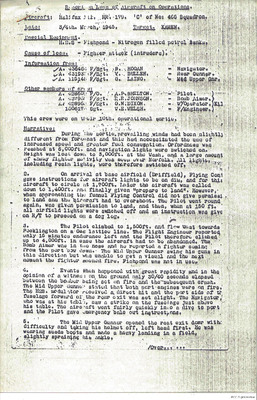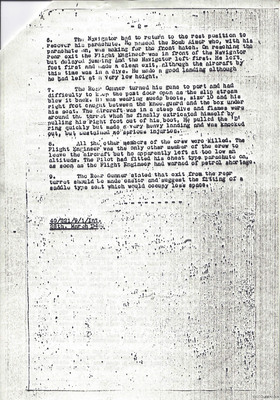Report on loss of aircraft on operations
Title
Report on loss of aircraft on operations
Description
Gives account of Halifax of 466 Squadron in which P J Hogan was navigator being shot down by German intruder aircraft on night 3/4 March 1945. The navigator and two gunners baled out successfully. The engineer left the aircraft but his parachute did not open and he was killed along with the other members of the crew.
Date
1944-03-28
Language
Format
Two page typewritten document
Publisher
Rights
This content is available under a CC BY-NC 4.0 International license (Creative Commons Attribution-NonCommercial 4.0). It has been published ‘as is’ and may contain inaccuracies or culturally inappropriate references that do not necessarily reflect the official policy or position of the University of Lincoln or the International Bomber Command Centre. For more information, visit https://creativecommons.org/licenses/by-nc/4.0/ and https://ibccdigitalarchive.lincoln.ac.uk/omeka/legal.
Contributor
Identifier
SHoganPJ436464v30005
Transcription
[underlined] Report on Loss of Aircraft on Operations. [/underlined]
[underlined] Aircraft: [/underlined] Halifax III. NR. 179. 'C' of No: 466 Squadron.
[underlined] Date: [/underlined] 3/4th March, 1945. [underlined] Target. [/underlined] KAMEN.
[underlined] Special Equipment. [/underlined] H.2.S – Fishpond – Nitrogen filled petrol tanks.
[underlined] Cause of loss. [/underlined] – Fighter attack (intruders).
[underlined] Information from: [/underlined]
A. 136464 F/Sgt. P. HOGAN – Navigator.
A. 431933 F/Sgt. V. BULLEN. - Rear Gunner.
A. 115148 F/Sgt. G. LAING. - Mid Upper Gnr.
[underlined] Other members of crew: [/underlined]
A. 428602 F/O A.P. SHELTON – Pilot. Killed.
A. 437965 F/Sgt. R.R. JOHNSON. - Bomb Aimer. Killed.
A. 428968 F/Sgt. G.N. DIXON. - W/Operator. Killed
1606174 Sgt. W.E. WELSH. - F/Engineer. Killed
This crew were on their 10th Operational sortie.
[underlined] Narrative: [/underlined]
During the sortie, prevailing winds had been slightly different from forecast and this had necessitated the use of increased speed and greater fuel consumption. [indecipherable word] was reached at 6,000ft. And navigation lights were switched on. Height was lost down to 3,000ft. at the Wash, and a large amount of enemy fighter activity was seen over Norfolk. All lights, including resin lights, were therefore switched off.
2. On arrival at base airfield (Driffield), Flying Control gave instructions for aircraft lights to be dim, and for this aircraft to circle at 1,700ft. Later the aircraft was called down to 1,400ft, and finally given “prepare to land”. However, when approaching the funnel Flying Control did not give permission to land and the aircraft had to overshoot. The Pilot went round again, was given permission to land, and then when at 150ft. On R/T to proceed on a dog leg.
3. The Pilot climbed to 1,500ft. And flew West towards Pocklington on a Gee lattice line. The flight Engineer reported only 16 minutes endurance left and the Pilot therefore climbed up to 4,000ft. In case the aircraft had to be abandoned. The Bomb Aimer was in the nose and he reported a fighter coming from the port bow down. The Mid Upper gunner swing [sic] his guns in this direction but was unable to get a visual and the next moment the fighter opened fire. Fishpond was not in [indecipherable word].
4. Events then happened with great rapidity and in the opinion of a witness on the ground only 30/40 seconds elapsed between the bomber being set on fire and the subsequent crash. The Mid Upper gunner stated that both port engines were on fire. The H2S. modulator received a direct hit and the port side of the fuselage forward of the rear exit was set alight. The Navigator, who was at his table, saw a strike on the fuselage just above his table. The Aircraft went fairly quickly into a dive to port and the Pilot gave emergency bale out instructions.
5. The Mid Upper Gunner opened the rear exit door with difficulty and taking his helmet off, left head first. He was wearing suede boots and made a heavy landing in a field, a lightly spraining his ankle,
/over..
[page break]
6. The Navigator had to return to the rest position to recover his parachute. He passed The Bomb Aimer who, with his parachute on, was making for the front hatch. On reaching the rear exit the Flight Engineer was in front of the Navigator but delayed jumping and the Navigator left first. He left feet first and made a clean exit, although the aircraft by this time was in a dive. He made a good landing although he had left at very low height.
7. The Rear Gunner turned his guns to port and had difficulty to keep the port door open as the slip stream blew it back. He was wearing suede boots, size 10 and is right foot caught between the knee guard and the box under his seat. The aircraft was in a steep dive and flames were around the turret when he finally extricated himself by pulling his right foot out of his boot. He pulled the ‘D’ ring quickly but made a very heavy landing and was knocked out, but sustained no serious injuries.
8. All the other members of the crew were killed. The Flight Engineer was the only other member of the crew to leave the aircraft but he apparently left at too low an altitude. The Pilot had fitted his chest type parachute on as soon as the flight Engineer had warned of petrol shortage.
9. The Rear gunner stated that exit from the rear turret should be made easier and suggest the fitting of a saddle type seat which would occupy less space.
[underlined] 4G/221/9/1/Int.
28th. March 1945 [/underlined]
[underlined] Aircraft: [/underlined] Halifax III. NR. 179. 'C' of No: 466 Squadron.
[underlined] Date: [/underlined] 3/4th March, 1945. [underlined] Target. [/underlined] KAMEN.
[underlined] Special Equipment. [/underlined] H.2.S – Fishpond – Nitrogen filled petrol tanks.
[underlined] Cause of loss. [/underlined] – Fighter attack (intruders).
[underlined] Information from: [/underlined]
A. 136464 F/Sgt. P. HOGAN – Navigator.
A. 431933 F/Sgt. V. BULLEN. - Rear Gunner.
A. 115148 F/Sgt. G. LAING. - Mid Upper Gnr.
[underlined] Other members of crew: [/underlined]
A. 428602 F/O A.P. SHELTON – Pilot. Killed.
A. 437965 F/Sgt. R.R. JOHNSON. - Bomb Aimer. Killed.
A. 428968 F/Sgt. G.N. DIXON. - W/Operator. Killed
1606174 Sgt. W.E. WELSH. - F/Engineer. Killed
This crew were on their 10th Operational sortie.
[underlined] Narrative: [/underlined]
During the sortie, prevailing winds had been slightly different from forecast and this had necessitated the use of increased speed and greater fuel consumption. [indecipherable word] was reached at 6,000ft. And navigation lights were switched on. Height was lost down to 3,000ft. at the Wash, and a large amount of enemy fighter activity was seen over Norfolk. All lights, including resin lights, were therefore switched off.
2. On arrival at base airfield (Driffield), Flying Control gave instructions for aircraft lights to be dim, and for this aircraft to circle at 1,700ft. Later the aircraft was called down to 1,400ft, and finally given “prepare to land”. However, when approaching the funnel Flying Control did not give permission to land and the aircraft had to overshoot. The Pilot went round again, was given permission to land, and then when at 150ft. On R/T to proceed on a dog leg.
3. The Pilot climbed to 1,500ft. And flew West towards Pocklington on a Gee lattice line. The flight Engineer reported only 16 minutes endurance left and the Pilot therefore climbed up to 4,000ft. In case the aircraft had to be abandoned. The Bomb Aimer was in the nose and he reported a fighter coming from the port bow down. The Mid Upper gunner swing [sic] his guns in this direction but was unable to get a visual and the next moment the fighter opened fire. Fishpond was not in [indecipherable word].
4. Events then happened with great rapidity and in the opinion of a witness on the ground only 30/40 seconds elapsed between the bomber being set on fire and the subsequent crash. The Mid Upper gunner stated that both port engines were on fire. The H2S. modulator received a direct hit and the port side of the fuselage forward of the rear exit was set alight. The Navigator, who was at his table, saw a strike on the fuselage just above his table. The Aircraft went fairly quickly into a dive to port and the Pilot gave emergency bale out instructions.
5. The Mid Upper Gunner opened the rear exit door with difficulty and taking his helmet off, left head first. He was wearing suede boots and made a heavy landing in a field, a lightly spraining his ankle,
/over..
[page break]
6. The Navigator had to return to the rest position to recover his parachute. He passed The Bomb Aimer who, with his parachute on, was making for the front hatch. On reaching the rear exit the Flight Engineer was in front of the Navigator but delayed jumping and the Navigator left first. He left feet first and made a clean exit, although the aircraft by this time was in a dive. He made a good landing although he had left at very low height.
7. The Rear Gunner turned his guns to port and had difficulty to keep the port door open as the slip stream blew it back. He was wearing suede boots, size 10 and is right foot caught between the knee guard and the box under his seat. The aircraft was in a steep dive and flames were around the turret when he finally extricated himself by pulling his right foot out of his boot. He pulled the ‘D’ ring quickly but made a very heavy landing and was knocked out, but sustained no serious injuries.
8. All the other members of the crew were killed. The Flight Engineer was the only other member of the crew to leave the aircraft but he apparently left at too low an altitude. The Pilot had fitted his chest type parachute on as soon as the flight Engineer had warned of petrol shortage.
9. The Rear gunner stated that exit from the rear turret should be made easier and suggest the fitting of a saddle type seat which would occupy less space.
[underlined] 4G/221/9/1/Int.
28th. March 1945 [/underlined]
Collection
Citation
“Report on loss of aircraft on operations,” IBCC Digital Archive, accessed July 27, 2024, https://ibccdigitalarchive.lincoln.ac.uk/omeka/collections/document/31992.
Item Relations
This item has no relations.


